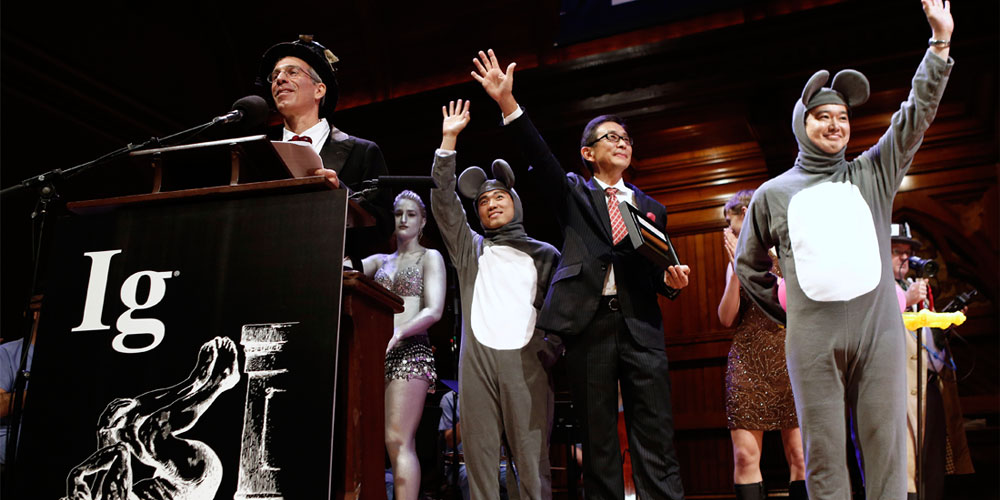Wacky Ig Nobel prizes show the funny side of science

Master of ceremonies Marc Abrahams, left, introduces the winners of the Medicine Prize, Xiangyuan Jin, right mouse, of China, Masanori Niimi of Japan and Masateru Uchiyama of Japan during the annual Ig Nobel prize ceremony at Harvard University Thursday, Sept. 12, 2013 in Cambridge, Mass. They won for assessing the effect of listening to opera on heart transplant patients who are mice. Organized by the science humor magazine Annals of Improbable Research (AIR), in cooperation with several Harvard student groups, the Ig Nobels celebrate the unusual, honors the imaginative, and spurs interest in science. (AP Photo/Winslow Townson). AP Photo/Winslow Townson
NEW YORK CITY – The tongue-in-cheek Ig Nobel awards were handed Thursday to dozens of scientists, including those who confirmed drunk people think they are more attractive and studied the onion enzyme that makes us cry.
The Nobel prize spoof honors achievements “that first make people laugh and then make them think,” according to a press release.
The Ig Nobels invite real Nobel laureates to confer honors on serious scientists for work that is generally only unintentionally funny.
There is also a peace prize, which this year was jointly awarded to the president of Belarus Alexander Lukashenko, for making it illegal to applaud in public, and to the Belarus police “for arresting a one-armed man for applauding.”
The safety engineering prize went to late American researcher Gustano Pizzo, who invented a system to trap airplane hijackers, seal them into a package and parachute them into the hands of police.
A team from the Britain, Netherlands and Canada were awarded the probability prize for determining that the longer a cow has been lying down, the more likely it is it will soon stand up.
They also discovered that once a cow stands up, you cannot easily predict how soon it will lie down again.
The physics prize went to researchers who discovered that some people would be physically capable of running across the surface of a pond — if those people and that pond were on the moon.
A joint award in biology and astronomy was given to a team from Sweden, Australia, Germany, Australia and the UK , who uncovered the fact that when dung beetles get lost, they can navigate their way home by looking at the Milky Way.
The study by researchers who confirmed drunk people really do think they are more attractive won the Psychology Prize.
A team from Japan and Germany tackled the age-old question of why onions make us cry and discovered merely that the biochemical process is “even more complicated than scientists previously realized.”
The archaeology prize went to a US-Canada team who parboiled a dead shrew, swallowed it without chewing, and then carefully examined their excretions to see which bones dissolve inside the human digestive system.
It was the 23rd edition of the Ig Nobels, awarded at the uber-prestigious Harvard University in Boston.
The prize-winners, who travel to the ceremony at their own expense, were given 60 seconds for an acceptance speech, a time limit enforced by an implacable eight-year-old girl.
The ceremony also included the premiere of a mini-opera called “The Blonsky Device,” inspired by the life and work of 1999 Ig Nobel Prize winners George and Charlotte Blonsky.
The couple invented a machine to aid women in giving birth by strapping her onto a circular table, which is then rotated at high speed.














